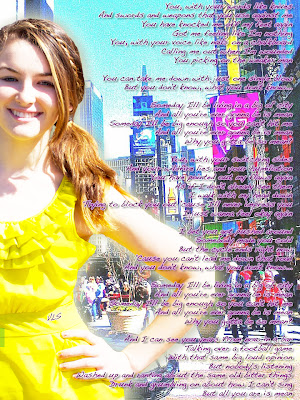Woohoo, a mini-project! I love mini-projects. It's hard to do something really meaningful in one class period, but sometimes big tasks are overwhelming and I get bored by the end. A mini-project is the perfect in-between...a few days to do something cool and then you're on to the next big thing!
Ok, enough small talk, on to the project...
Since I'm not with you in class this week, it is the perfect time for you to dip in to the history of photography and learn a little about how cameras have evolved. I would like you to present your findings in a glog. This means that you must know your glog username and password! It should be the same info that you use to login to the computers at NFS.
If you need help, email me during Monday's class period. I will be online during that time period and will be able to help you reset your password very quickly. *Remember to login to edu.glogster.com * If you go to regular ol' glogster.com, your usernames won't work.
You have four class periods (Mon, Wed, Thurs & Fri) to complete this project. I will be able to track your progress via Glogster and will link them all together into one super glog. You can work on your glog at home if you like, but this isn't necessary so long as you use your class time efficiently :) Efficiency is great. You should give it a whirl.
Oh wait. Before we go any further. Let me be clear.
DO NOT PLAGIARIZE! No! Don't even think about it. This is super duper important so listen up. I expect you to make every effort to use your own phrases and sentence composition. Lots of times you'll hear teachers say "put it in your own words." That is all good, but some words can't be changed. For example, there's really only one word for camera. What teachers mean is that you have to put the words together in your own way. I shouldn't be able to Google a chunk or sentence from your writing and find it online in someone else's.
So no plagiarism, ok? Promise? Ok, phew. We can keep going now.
In your glog, you must include the following:
- When did photography start? See if you can find out who/what/when/where, as that's a pretty easy way to organize this kind of thing. [a beefy paragraph at most]
- How did the first photographs actually get made? We're talking physically here. What did they actually use to make the photos? [a beefy paragraph at most]
- When did digital photography start? See if you can find out who/what/when/where. [a beefy paragraph at most]
- How has the digital photography changed the world? If you Google this question, you'll find a range of different ideas and opinions. There isn't necessarily one right or wrong answer here. That's a-ok and whatever you decide is fine by me. The best questions often have no clear answer, and my goal is for you to think. [a beefy paragraph at most]
- Who is a famous photographer? How did she or he influence photography? There are loads of people to choose from. Pick anyone you want. [a beefy paragraph at most]
- At least three pictures! This IS photography class, after all!
- A bibliography of your sources. You should have at least three. Use MLA format. It's okay to use www.easybib.com or www.bibme.com See Ms. Hensley if you need help with this.
Here are a few more options. I like choices, and maybe you do too.
* Instead of typing out your paragraphs, you can do audio recordings. The perks of this method are that you don't have to worry about spelling and punctuation. Woot! And, as if that wasn't enough of a reason to try this out, you also get to use those nifty audio players that Glogster has. So cool. Ms. Chiko would say "huzzah!" about this option. Instead, I'm going to say "YOWZA!" Ask Jody Smith about YOWZA. Don't tell her why though. Just say, "hey Jody, I just want to say YOWZA!" Trust me, she will definitely love this and give you mental brownie points. And who doesn't want mental brownie points from Queen Jody? Ok, back to the options...
* Instead of jamming all this in one single glog, you can build two or more glogs and then link them. This doesn't necessarily mean you're writing more. It just means you can make your text bigger (easier to read), use larger pictures, add more spinning graphics, etc. I bet a lot of you are thinking no way am I doing this. That seems like a boatload more work. Personally, I think this maybe takes a little more work, but not really if I want my glogs to look good. Crowded and cramped is no fun for anyone, including glogs. Give your glog a little room to breathe and stretch out, ok?
All-righty, that's probably enough to get you started on this fine Monday morning. I rambled a bit here tonight so you better get going. Efficiency, right?
Peace y'all.
~ K






















